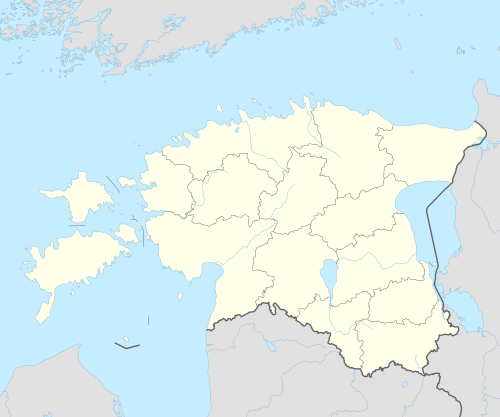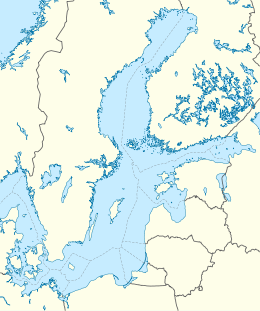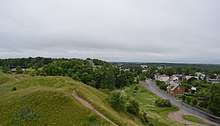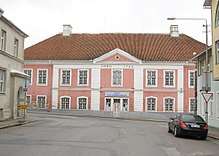Rakvere
Rakvere is a town in northern Estonia and the capital of Lääne-Viru County, 20 km south of the Gulf of Finland of the Baltic Sea. Until early 20th century Rakvere was more widely known by its historical German name Wesenberg(h).
Rakvere | |
|---|---|
View over Rakvere | |
 Flag  Coat of arms | |
| Motto(s): Väge täis (Full of might) | |
 Rakvere Location in Estonia  Rakvere Rakvere (Baltic Sea)  Rakvere Rakvere (Europe) | |
| Coordinates: 59°21′N 26°21′E | |
| Country | Estonia |
| County | Lääne-Viru County |
| Government | |
| • Mayor | Triin Varek (Estonian Centre Party) |
| Area | |
| • Total | 10.64 km2 (4.11 sq mi) |
| Elevation | 82 m (269 ft) |
| Population (2017) | |
| • Total | 15,737 |
| • Rank | 7th |
| • Density | 1,500/km2 (3,800/sq mi) |
| Ethnicity | |
| • Estonians | 88% |
| • Russians | 8% |
| • other | 2.8% |
| Time zone | UTC+2 (EET) |
| • Summer (DST) | UTC+3 (EEST) |
| Postal code | 44306 |
| Area code(s) | (+372) 032 |
| Vehicle registration | R |
| Website | www |

History
The earliest signs of human settlement dating back to the 3rd–5th centuries AD have been found on the present theatre hill. Probably to protect that settlement, a wooden stronghold was built on the present Vallimägi. When it changed owners in 1220, the Danes started to erect buildings from stone. A settlement called Tarvanpea was first mentioned in the Chronicle of Henry of Livonia in 1226. The new Danish stronghold was called Wesenbergh in Middle Low German for the first time in 1252. The battle of Wesenberg between the Danish and German knights and Russians occurred nearby on 18 February 1268.
On 12 June 1302, Rakvere was granted Lübeck rights. When the Danish king sold Danish Estonia to the Livonian Order in 1346, a large castle was built on top of the previous stronghold. The Ordensburg was protected by towers and courtyards. The building of a Franciscan monastery was started in 1508.
During the Livonian War from 1558 to 1581, Rakvere was under Russian rule and was heavily damaged. Sweden, after the disastrous Siege of Wesenberg (1574),[1] captured the town in 1581[2] before it passed to the Polish-Lithuanian Commonwealth in 1602; Poles destroyed the castle in 1605. After being returned to Swedish control in that year, a mansion was built on the ruins of the monastery. During the Great Northern War, Rakvere was burned down in 1703. With the Capitulation of Estonia and Livonia in 1710 and the subsequent Treaty of Nystad in 1721, Rakvere passed to the Russian Empire, where it remained until Estonia's independence in 1918 following World War I.
During the first period of independence, many prominent buildings were built, such as the market building, the old bank building (current SEB Eesti Ühispank), and Rakvere Gymnasium. In 1930, the town stadium was opened, during the tenure of mayor Heinrich Aviksoo. Local newspapers started to emerge, including the county paper Virumaa Teataja, which was first published in 1925. The idea of Rakvere's own professional theatre started to take shape as well. The construction of the theatre house was completed at the end of the 1930s and it was festively opened on 24 February 1940. The theatre survived World War II and is active to this day.
Rakvere also has a professional theatre and it is believed that it is the smallest town in Europe which has a professional theatre.[3] Its roots date back to 1882 and it is still active and very popular. The theatre of Rakvere has given Estonia many famous actors and actresses such as Volli Käro, Üllar Saaremäe, Indrek Saar, Ülle Lichtfeldt, Aarne Üksküla etc. It also holds the biannual event Baltoscandal, which gathers avant-garde plays and groups from all over the world.
Main landmarks
Tarvas statue
.jpg)
Rakvere is also known now for its Tarvas statue of an aurochs, which was made by the Estonian sculptor Tauno Kangro. It is thought to be the largest animal statue in the Baltic countries.
It is situated on the edge of Vallimägi hill and was erected for the town's 700th birthday. Along with the granite block it sits on, the statue is seven meters long and four meters high and weighs about seven tons.
The statue is made out of bronze. The names of the companies and private people who financed it are engraved in the granite block.
Rakvere Trinity church
The Lutheran church of Rakvere, the Trinity church, originally dates from the 15th century and was designed to also be able to function as a stronghold in times of trouble. It was severely damaged during the Livonian War and renovation started only in 1684. During the Great Northern War, the church once more was damaged by fire twice. Renovations were carried out 1727–1730, and again during the middle of the 19th century, when the church received its present look, dominated by its neo-Gothic spire. The interior displays some fine craftsmanship, including a Baroque pulpit from 1690 made by Christian Ackermann.[4]
Twin towns - sister cities
Rakvere is twinned with:[5]









Distances
Sports
Sports clubs
- Basketball
- BC Rakvere Tarvas – a men's basketball team, runner-up of 2009–10 Estonian Championships and 2010 Estonian Cup. The club takes part in Korvpalli Meistriliiga and Challenge Cup
- Volleyball
- VK Rivaal Rakvere – a men's volleyball team, multiple Estonian Champion and Cup winner. The club takes part in Schenker League
- Football
- Rakvere JK Tarvas – an amateur football club established in 2004. The club plays in Estonian Esiliiga (second tier in Estonian football) as of 2012. The home ground is Rakvere linnastaadion.
Sports events
- Amateur Sumo World Championships 2008
- U19 EURO2012
Gallery
 Rakvere castle
Rakvere castle Rakvere town center
Rakvere town center Rakvere theatre
Rakvere theatre Rakvere marketplace
Rakvere marketplace Rakvere Trinity Church
Rakvere Trinity Church Hotel Wesenberg
Hotel Wesenberg Rakvere manor park
Rakvere manor park- Rakvere main square
 St.Paul Church
St.Paul Church Estonian Police Museum
Estonian Police Museum- Street in Rakvere
 Rakvere main manor and theatre
Rakvere main manor and theatre
References
- Peterson, Gary Dean (2007). Warrior kings of Sweden. The rise of an empire in the sixteenth and seventeenth centuries. McFarland. pp. 91–92. ISBN 0-7864-2873-2.
- Black, Jeremy (1996). Warfare. Renaissance to revolution, 1492–1792. Cambridge Illustrated Atlases. 2. Cambridge University Press. p. 59. ISBN 0-521-47033-1.
- Taul, Gregor. "Turism ja linnamaastikud Pihkvas". Sirp. 22 December 2011. Accessed 4 April 2012. (in Estonian)
- Viirand, Tiiu (2004). Estonia. Cultural Tourism. Kunst Publishers. p. 129. ISBN 9949-407-18-4.
- "Sõpruslinnad". rakvere.kovtp.ee (in Estonian). Rakvere linn. Retrieved 2019-11-07.
External links
| Wikimedia Commons has media related to Rakvere. |
| Wikivoyage has a travel guide for Rakvere. |